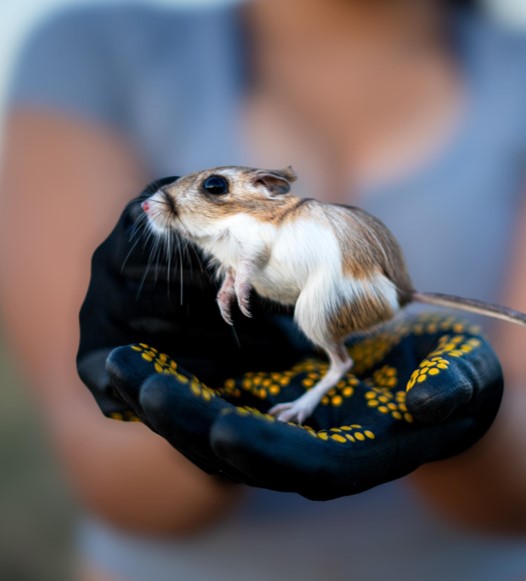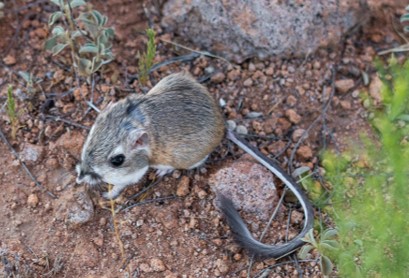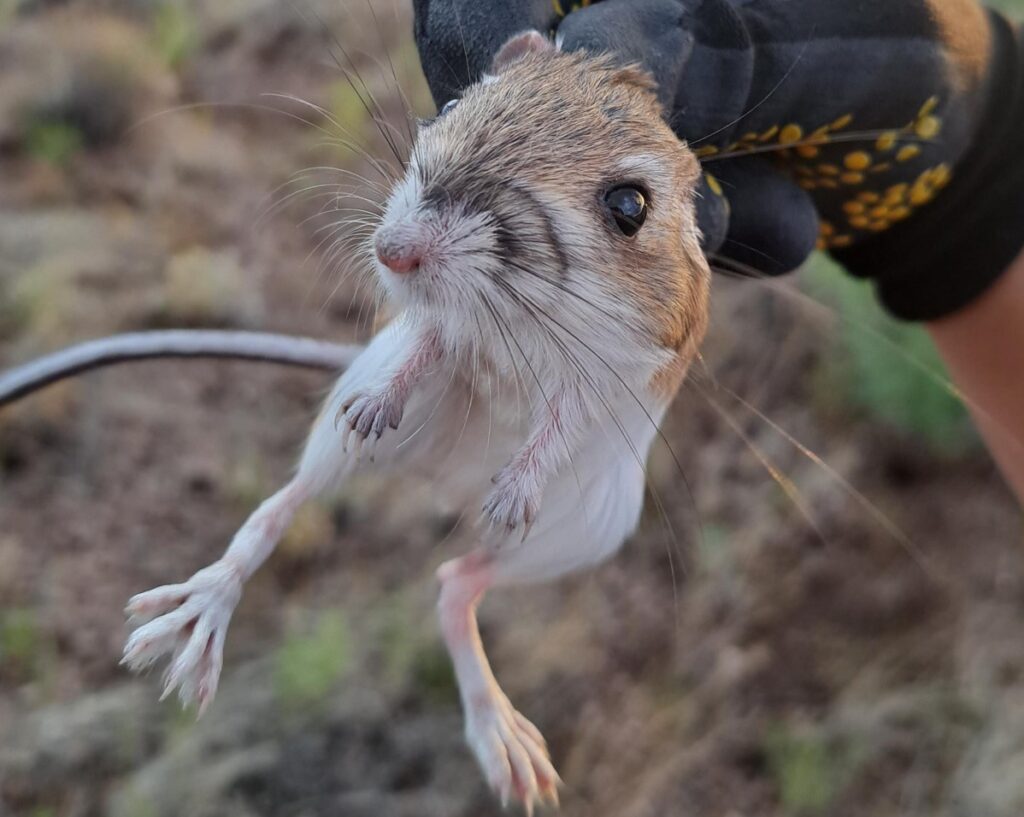By Maria Conklin

The City of Rocks State Park is a habitat rich in various desert rodent species. One of the many species inhabiting this area are kangaroo rats. Kangaroo rats have unique eating habits that allow them to survive in arid environments. They primarily feed on seeds, making them herbivores. Seeds are a vital part of their diet, providing the necessary nutrients and energy to thrive in their desert habitats. Here in southwest New Mexico, kangaroo rats’ diets consist of mesquite beans and various grass seeds which have a high water content. Kangaroo rats drink little to no water, so they must consume foods that contain enough water to keep them hydrated.

To adapt to their limited water intake, kangaroo rats have developed efficient water conservation mechanisms. They conserve water by producing concentrated urine and minimizing water loss through their skin. Their digestive system is specialized for processing dry food, that extracts as many nutrients as possible from the seeds they eat. They primarily forage at night when temperatures are cooler, and humidity levels are higher. They also utilize their cheek pouches to store food, providing a reserve of moisture-rich seeds.

Kangaroo rats have a highly developed sense of smell, which is a common trait among rodents that primarily eat seeds. Therefore, when mammologists study rodents in the field, they use vanilla extract and oats as bait to attract them. Therefore, I decided to conduct an independent research project that explored the possibility of other bait types being just as successful at attracting wild rodents as vanilla and oats do.
I began my research by setting up Sherman traps in the west, north, and east regions of the park boundaries during the afternoon. Kangaroo rat burrows were located to set up the traps near regions where there would be activity during the night. There were 6 areas of interest in the park where the traps were set and where the replicates of this project took place. The three different bait types used were vanilla and oats, strawberry jelly and oats, and peanut butter and oats. When a rodent was caught, its species and sex were identified, and the type of bait they chose was noted for later analysis.

Throughout the project, two species of kangaroo rats were caught: Dipodomys merriami (Merriam’s Kangaroo Rat), and Dipodomys ordii (Ord’s kangaroo rat). Merriam’s kangaroo rat was more attracted to vanilla extract and oats when paired with peanut butter and oats or strawberry jelly and oats. Strawberry jelly and oats attracted more Merriam’s kangaroo rats when paired with peanut butter and oats. Overall, they preferred vanilla the most. Ord’s Kangaroo rat was not more attracted to vanilla extract and oats when paired with strawberry jelly and oats, but it was when it was compared to peanut butter and oats. Ord’s kangaroo rat was not more attracted to either of the bait types when the peanut butter mix and strawberry jelly mix were paired. There was no preference for vanilla. Non-kangaroo rat species that were also considered for analysis were Peromyscus eremicus (cactus mouse), Peromyscus maniculatus subspecies blandus (deer mouse), Chaetodipis penicillatus (desert pocket mouse), and Perognathus flavus (silky pocket mouse). All the non-kangaroo rat species had a preference for the strawberry bait mixture over the others. The key takeaway from the results was that the Merriam’s kangaroo rats were consistently more attracted to the vanilla extract.
These results raised the question if components of the vanilla extract are attracting kangaroo rats and if it has any correlation to their natural environment. As stated before, mesquite seeds are a primary source in a kangaroo rat’s diet and some results from other research projects also suggest that there may be some correlations between the chemical components within mesquite seeds and vanilla extract aromas. Additionally, other researchers found that mesquite seeds contain precursors to vanillin. As the City of Rocks is a lowland, shrubland environment, it is highly populated with mesquite seeds. Therefore, this could explain why vanilla was effective at attracting kangaroo rats that were studied in this project.
The City of Rocks State Park was an excellent place to conduct my research project as it provided the perfect habitat to observe kangaroo rats in their natural setting. I would like to thank the City of Rocks staff for allowing me to conduct my research in the area. I would also like to give a special thanks to Dr. William Norris and Dr. Manda Jost of the Natural Sciences Department at Western New Mexico University for their guidance and assistance throughout my project.
